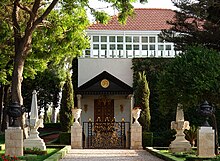バハオラの霊廟
この記事の文章は日本語として不自然な表現、または文意がつかみづらい状態になっています。 |
この項目「バハオラの霊廟」は途中まで翻訳されたものです。(原文:英語版 "Shrine of Baháʼu'lláh" 17:04, 14 January 2023 (UTC)) 翻訳作業に協力して下さる方を求めています。ノートページや履歴、翻訳のガイドラインも参照してください。要約欄への翻訳情報の記入をお忘れなく。(2023年9月) |
バハオラの霊廟(バハオラのれいびょう、Shrine of Baháʼu'lláh)、バージの館(バージのやかた、アラビア語:قصر بهجي, Qasr Bahjī, mansion of delight)は、イスラエルのアッコにある夏の家で、バハイ教の開祖であるバハオラが1892年に死去したところ。
| バハオラの霊廟 [1] | |
|---|---|
 | |
| 座標 | 北緯32度56分36秒 東経35度05分32秒 / 北緯32.94333度 東経35.09222度 |
| 所在地 | Bahjí |
| 種類 | Baháʼí |
隣接する家に埋葬され、巡礼の地であるバハオラの霊廟となり、バハイのゲブレ[2]ともなりました。この一帯は「アル・バハジャー(喜びの場所)」と呼ばれるようになりました。
バージの館 編集
バハオラの息子 アブドル・バハ は、父であるバハオラとその家族が住むためにこの邸宅を借り、その後購入しました。バハオラははマズライからバージに移り、亡くなるまでこの建物に住んでいました。[3][4] 1890年、ケンブリッジの東洋学者 Edward Granville Browne はこの家でバハオラに会い、 この後、有名なバハオラのペン画を描きました。
1892年に亡くなったバハオラは、周囲の建物のひとつに埋葬されました。[5] 敷地内にはハラム・イ・アクダス(最も神聖な境内または聖域)と呼ばれる楽園が整備され、バハオラの廟を周回する円形の道が交差しています。[5] 邸宅、霊廟、周囲の庭園は、バハイ教徒にとって地球上で最も神聖な場所の一つであり、バハイ教徒の巡礼地となっています。[3][5]
バハイの聖地であるバハオラの霊廟の内部は、小さな木が植えられている箱庭状の庭園を含む中央の部分と、ペルシャ絨毯が敷かれた回廊によって構成されています。バハオラの死後、クラム・アリ・イ・ナジャル[6]によりガラスの屋根が建設されました。中央エリアの北西隅には、バハオラの遺骸が納められた小さな部屋があります[7]。中央エリアには、巡礼者や訪問者の数の増加に対応するために近年開かれた他の部屋への扉があります。
日々の必須の祈りを唱える際、バハイ教徒はケブレ(聖地)であるバハオラの霊廟に向かって行われます。これは、イスラム教徒が日々の祈りでカアバの方角に向くことや、キリスト教徒やユダヤ教徒がエルサレムに向くことと似ています。バーブは「神が明らかにする者」の再来を予言し祈りの方角をその人物に向けるよう教えましたが、バハオラの出現により、バハオラの生存中はバハイ教徒は彼の姿に向かって祈ることとなり、バハオラが埋葬されケブレの場所が確定しました[要出典]。このことを説明する書簡が存在しましたが、それらは破壊者により盗まれてしまいました。
バハオラの霊廟及びその周囲の庭園、さらにバージの館は2028年7月に世界遺産として登録されました[8][9]。
この地域は元々アッコの統治者だったスレイマン・パシャが娘のファティミのために植えた庭園で、彼はそれをバジと名付け[3] その後、この地域はアブドラ・パシャによってさらに美化され、1831 年にイブラヒム・パシャがアッコを包囲して以降、彼はその敷地を本拠地として利用[3] この土地は、美しい庭園と水道水が流れ込む池泉でよく知られていた。その後、その不動産はクリスチャン一家ジャマル家の所有になる[3]
In 1870 ʻUdi Khammar, a wealthy merchant from Acre who also originally owned the House of ʻAbbúd, bought some of the land from the Jamals close to the mansion of ʻAbdu'llah Pasha and built the Mansion of Bahji, over an earlier and smaller building, which Abdu'llah Pasha had built for his mother.[10][3][5] Udi Khammar placed an Arabic inscription over the door in 1870 which reads: "Greetings and salutation rest upon this Mansion which increaseth in splendour through the passage of time. Manifold wonders and marvels are found therein, and pens are baffled in attempting to describe them."[4] ʻUdi Khammar had built the house for his family, and when he died was buried in a tomb in the south-east corner of the wall directly around the building.[3][11] In 1879 an epidemic caused the inhabitants to flee and the building became vacant.
The shrine, after ʻAbdu'l-Bahá's death, was occupied by Mírzá Muhammad ʻAlí and his supporters, who forcibly took the keys to the shrine in January 1922.[12] The governor of Acre ordered the keys to be returned to the authorities and a guard was posted at the shrine.[12] In early 1923 the keys were returned to Shoghi Effendi.[12] In the 1950s, Shoghi Effendi had made plans for a future superstructure, which would surround the whole area and would include a platform with 95 marble columns, each 6 meters high.[13] Shoghi Effendi has called the shrine the Daryá-yi-Núr (Ocean of Light), which has taken the Kúh-i-Núr (Mountain of Light, the Shrine of the Báb) under its shadow.[14]
At the entrance to these gardens stands a wrought iron decorative gate called "Collins Gate" named after Amelia Collins.[15]
脚注 編集
- ^ National Spiritual Assembly of the United States (January 1966). “Shrine of Baháʼu'lláh”. Baháʼí News (418): 4 2006年8月12日閲覧。.
- ^ “バハオラの霊廟”. www.bahaijp.org. 2023年6月4日閲覧。
- ^ a b c d e f g Balyuzi 2000, p. 362.
- ^ a b Taherzadeh 1987.
- ^ a b c d Smith 2000.
- ^ “Qulám-‘Alíy-i-Najjár”. Baha'i International Community. 2024年1月15日閲覧。
- ^ “Visits to the Shrine of Baha'u'llah and meeting with the Universal House of Justice”. Manvell. 2024年1月15日閲覧。
- ^ Centre, UNESCO World Heritage. “Three new sites inscribed on UNESCO’s World Heritage List” (英語). UNESCO World Heritage Centre. 2024年1月15日閲覧。
- ^ “Convention concerning the protection of the world cultural and natural heritage”. World Heritage Committee. 2024年1月15日閲覧。
- ^ Ruhe 1983, p. 106.
- ^ Taherzadeh 1987, p. 103.
- ^ a b c Wilson 2000.
- ^ Giachery 1973, pp. 134–4, 137.
- ^ Khadem 1976.
- ^ Ruhe 1983.
参考文献 編集
- Balyuzi, H.M. (2000). Baháʼu'lláh, King of Glory. Oxford, UK: George Ronald. ISBN 0-85398-328-3
- Giachery, Ugo (1973). Shoghi Effendi — Recollections. Oxford: George Ronald. ISBN 0-85398-050-0
- Khadem, Zikrullah (March 1976). “Baháʼu'lláh and His Most Holy Shrine”. Baháʼí News (540): 15.
- Ruhe, David (1983). Door of Hope: The Baháʼí Faith in the Holy Land. Oxford: George Ronald. ISBN 978-0853981503
- "Bahjí". A concise encyclopedia of the Baháʼí Faith.
- Taherzadeh, A. (1987). The Revelation of Baháʼu'lláh, Volume 4: Mazra'ih & Bahji 1877-92. Oxford, UK: George Ronald. ISBN 0-85398-270-8
- Wilson (2000年4月). “The Dispensation of Baha'u'llah: Its Continuing Place In History”. bahai-library.com. 2006年8月12日閲覧。